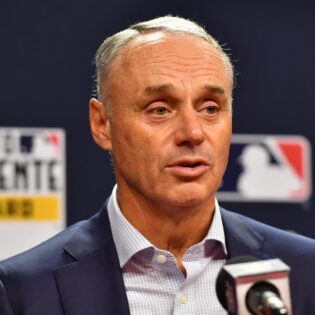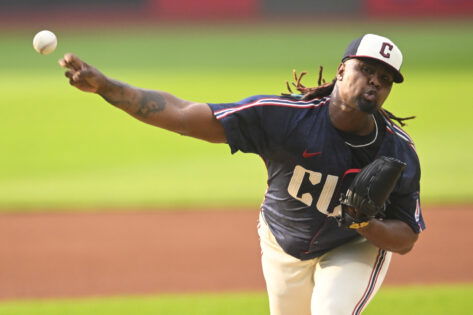Baseball fans might want to keep one eye on the field and the other on their streaming subscriptions. As the game evolves under the ever-watchful gaze of Commissioner Rob Manfred, some moves feel less like modernization and more like corporate chess. While pitchers like Max Scherzer battle pitch clocks and shrinking strike zones, it seems Manfred’s playing a longer game—one that might just end their wallet.
MLB commissioner, Rob Manfred recently gave an interview to The New York Times and there were many talking points. One of the main talking points was the TV deals and broadcasting rights. During that time, Manfred said, “We want to get out of the business of blackouts.” This was for the fans who face problems while streaming. He says that this will no longer be a problem but ex-Marlins president, David Samson thinks that something bigger is cooking behind the scenes.
During his podcast, Samson said, “Why would he want to talk about TV deals? Is it because he is in the middle of negotiating a major TV deal to replace ESPN’s $550 million deal which expires at the end of this year? Is it him trying to message the teams who are getting in his way of pooling all of the local broadcast revenue and then splitting it and making it all national?”
Though ESPN has carried MLB games since 1990, its coverage will conclude at the end of the 2025 season, which was announced back in February. Previously, both sides agreed to a seven-year deal in 2021 that averaged $550 million per season. However, there was a March 1 deadline that allowed both parties to opt out of the contract for the last three years. And that’s exactly what happened.
As compared to the contract between MLB and ESPN that existed between 2014 to 2021, the broadcast extended to 90 regular-season games, while the existing contract saw the broadcasting numbers drop to 30 regular-season games and the wild card postseason series.
Coming back to David Samson, he thinks that MLB is trying to do what they did with the San Diego Padres. After Diamond Sports Group (DSG) filed for bankruptcy, MLB stepped in to take control. In 2023, the league assumed responsibility for the production and distribution of all local San Diego Padres games.
This arrangement meant that the games could reach a wider audience, and it worked. The viewership increased by 189% and saw around 3.264 million homes getting live Padres games. If MLB manages to do this, it might work out very well for the league. It could also benefit all the teams involved.
And if the Padres were MLB’s test run, then the rest of the league might soon be stepping into the same broadcast bullpen. What looks like fan-first reform could also be a power consolidation play wrapped in a streaming package. Manfred’s not just rewriting the TV playbook—he might be drafting a new league economy. After all, in today’s MLB, even the curveballs are corporate.
Rob Manfred hints at big changes with automated Ball-Strike System
Baseball purists, brace yourselves—another sacred skill may be headed for the history books. As MLB continues its slow dance with technology, one particular tradition is teetering on the edge of extinction. It’s not the hit-and-run or the complete game—it’s something sneakier, subtler, and once thought untouchable. And if Rob Manfred has his way, players like Logan O’Hoppe might soon need a new calling card.
In his recent interview, MLB commissioner Rob Manfred discussed many things, including the new technology the MLB used in spring: ABS. It combines hawk-eye technology with human umpiring, which allows players to challenge calls. While not fully implemented, the ABS has become a major point of discussion in interviews and podcasts. While this may help the batters, it is not going to hurt the catchers and their skills.
Manfred said, “There is an argument about how it affects the kind of players in the game… If you have an automated strike zone, the framing catcher, he goes away.” He says that the value of catchers in a game is going to drastically reduce during a game. Most of the catchers who are good at framing balls might not be so useful after the addition of ABS to regular games.
And that’s the rub—what technology giveth to the batter, it taketh from the catcher. If framing becomes obsolete, teams may soon trade soft hands for strong arms and good Wi-Fi. The automated zone isn’t just a rule change; it’s a cultural shift. So enjoy those subtle wrist flicks while they last—because in the future, your favorite catcher might just be another guy squatting with a front-row seat to the robot revolution.
The post MLB Commissioner Rob Manfred’s TV Deal Comments Spark Suspicion as Ex-Marlins Prez Hints at Bigger Agenda appeared first on EssentiallySports.



